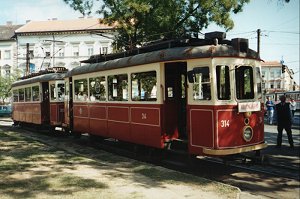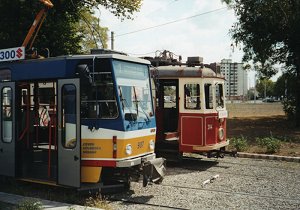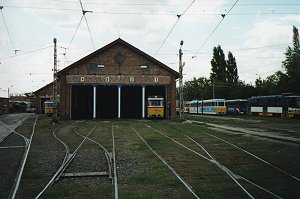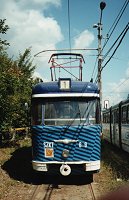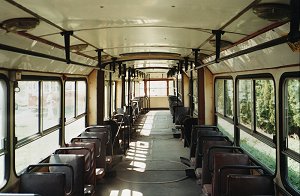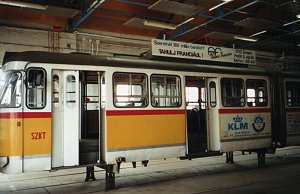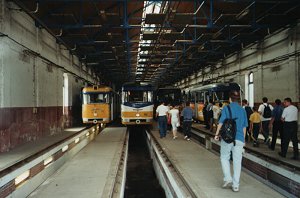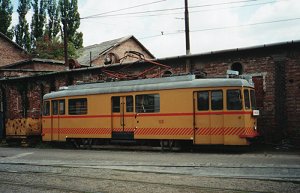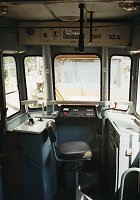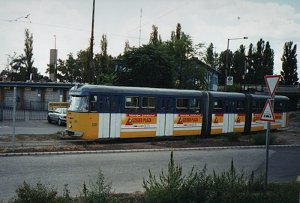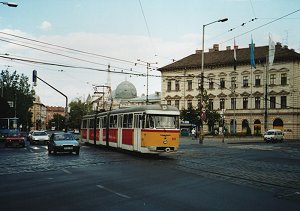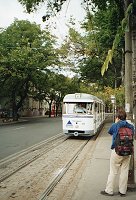budapest
other hungarian
close-up
lost rails
other countries
A not-so-small group of tram enthusiasts who know each other from the internet went to Szeged - one of the largest cities in Hungary - on the 26th of August, 2000. Szeged is worth visiting alone, but the city has also got the largest tram network in the country after Budapest. Originally it was bigger than now but then a few lines were cut back or stopped.
The organisers of this trip rented a nostalgy tram and we set out to the rails...
On this picture you can see our vehicle, the nostalgy tram 313-314, which is a twin-set originally used in Budapest under the numbers 2569-2573 (they weren't used together originally, this set was put together for Szeged) at Dugonics tér, which was rebuilt in 2002 so this track layout is gone now.
The interior of the museum tram is typical for hungarian trams used between the late 1950's and early 80's (although these cars were built around 1907, they received their current form in 1961): two-color wooden seats, wooden floor, light bulbs. The perrons on both end are divided from the cabin with two-wing traverses. In summertime the entrance doors are open, with collapsible bars securing the perron, in winter full-size doors are mounted on them.
The driver's post of car 314: to the left are the controller levers (the small is for forward/reverse, the bigger adjust the ammount of current switched to the motors), in the middle you can see the lever of the air brake system, and to the right is the wheel of the parking brake. Quite simple, isn't it?
The terminus of Route 1 at Rókus train station: in the foreground you can see a modern Tatra T6A2 car.
The depot of SZKT, the Szeged Public Transport Company. A classical remise building.
On the last picture you could see some trams I haven't introduced to you yet: these are the "Bengali" I refered to in the title of the page. These are the "home-made" articulated trams that were designed by the Budapest Tram Company (FVV) in 1960-61. They weren't really successful: they were in fact two 2-axle trams pivoted together, were weak, noisy and comfortless. The nickname "Bengali" was given to them because of the latter (Bengalia is a part of India, which was infamous for its poverty). Other names for this type: "home-made articulated", "FVV articulated", "Benga".
Despite their lack of comfort they have an appeal on tram fans - and they somewhat look like the P-cars of Munich.
The interior of a "home-made". Notice the interesting design of the lanterns over the seats!
There are different types of the Bengali: some of them
are uni- and some of them are bi-directional. Some of them have doors
on both sides, some of them only on one. Some of the "two-siders" have
6 doors, some of them have 10.
This is the driver's cab of a uni-directional, 3-door car.
A home-made without chassis.
Inside the depot.
This track and overhead maintenance tram (SZ5) is in fact another oldtimer from Budapest: its chassis was built originally in 1896, then rebuilt in the first decade of the XX. century, then the whole car was rebuilt in 1938 to be the prototype of the F1A-series, then rebuilt again in 1972, and then rebuilt once more to its current state in the 80's. How about that for an interesting life!
The body is a typical example for trams rebuilt with
steel-frame body between 1956 and 1972. During that time many streetcars
with wooden frame were rebuilt like that so we have a separate category
of "rebuilt with steel-frame body" trams in Hungary (1000, 1500, 1600,
1900, 2000, 2500, 2600, 2700). The 1500-series that this tram belonged
to were a bit distinct: their enterance doors at the perron ends were
twice as wide as the others'.
Of course SZ5 is still working!
The inside of the little brother of the 2-axle car just seen: SZ6, a production car of the F1A series, also rebuilt to maintenance service.
After visiting the remise, we went over to the trolley bus depot. Since I'm not a big fan of busses, I'll skip those photos and show you some more Bengalis! Above: a bi-directional Bengali near the depot.
Crossing at Anna kút.
The stop at Dugonics tér with a tram-spotter :-) Notice the one-arm (Einholm) overhead current collector!
Back to the top Back to the main page
